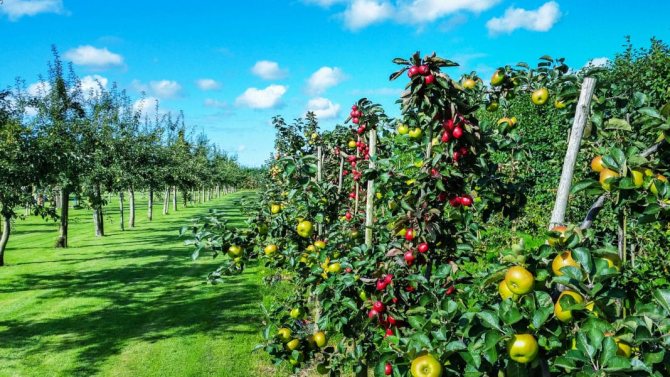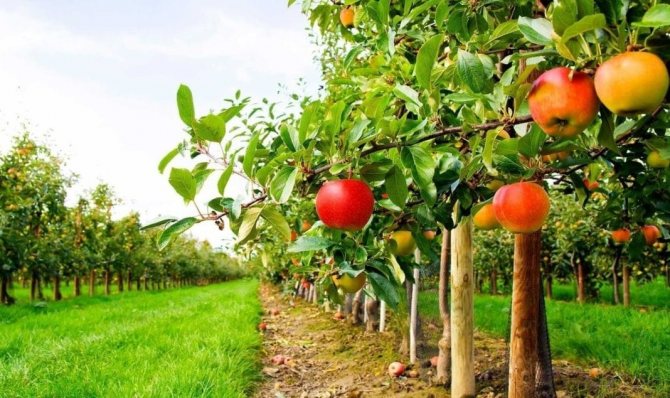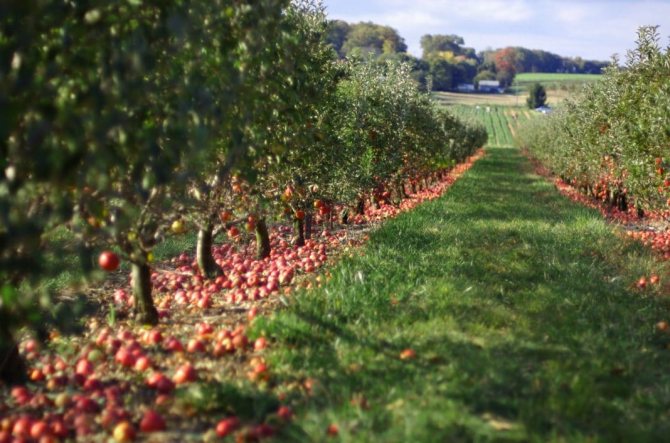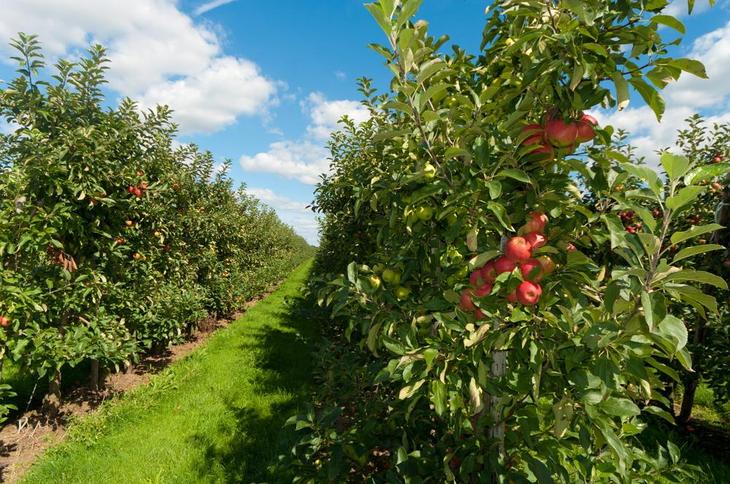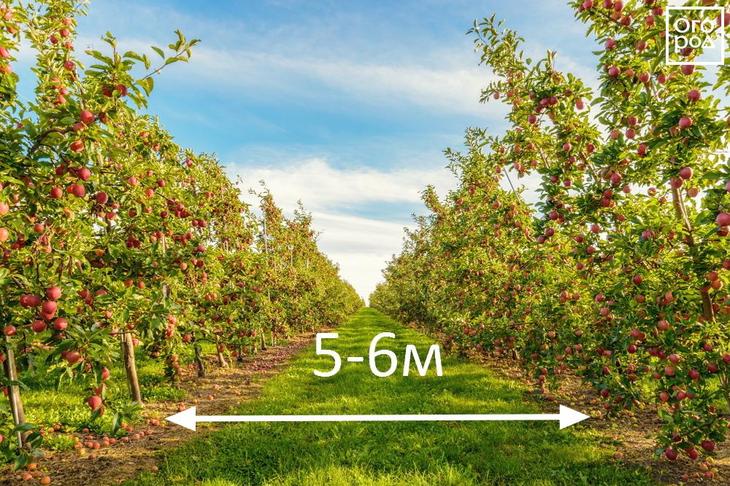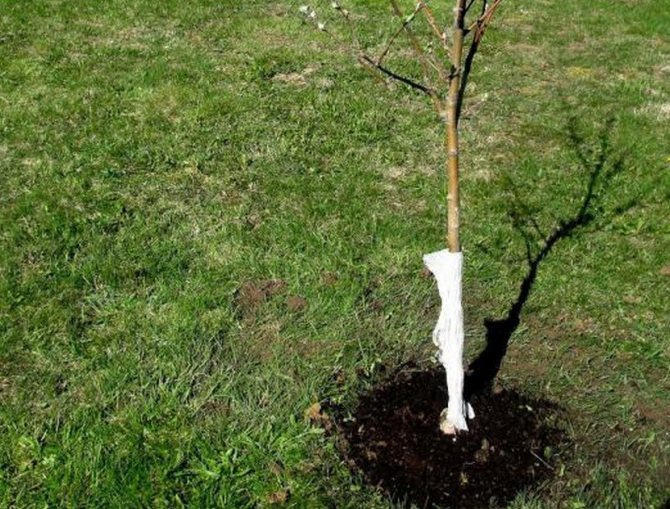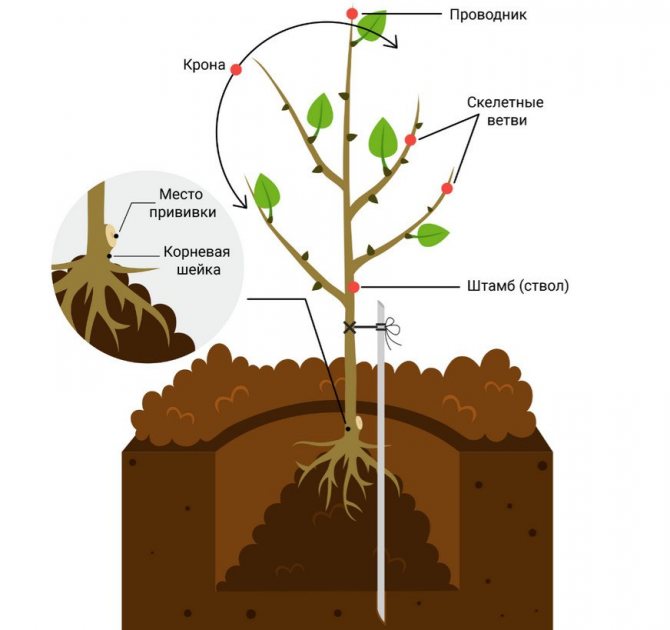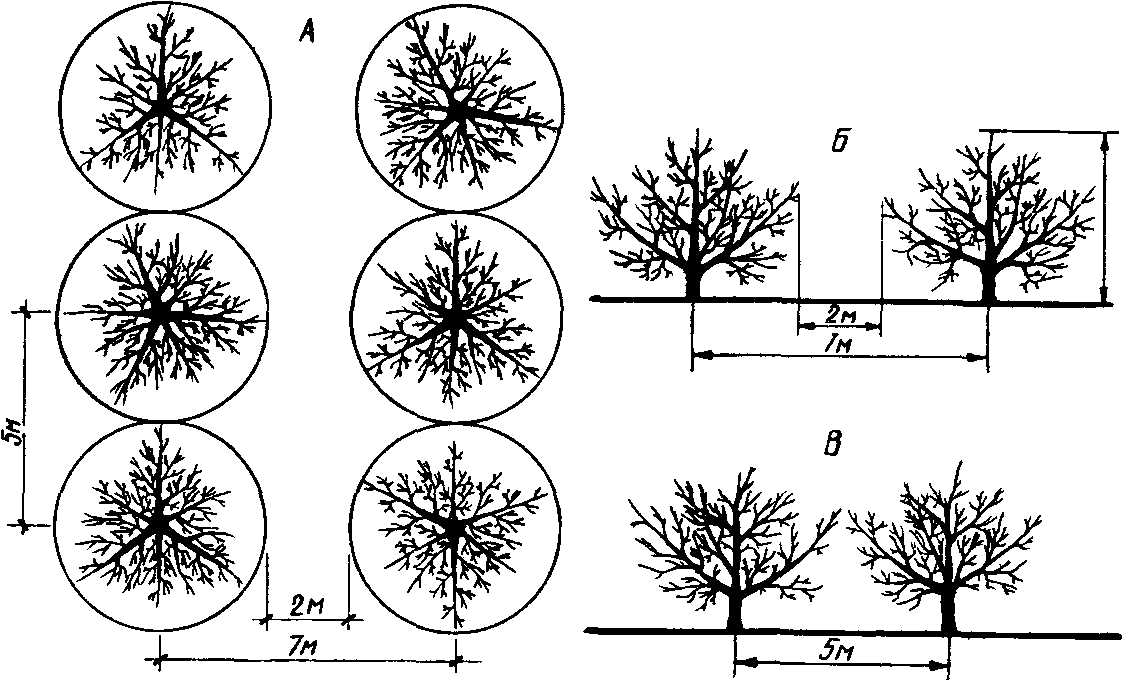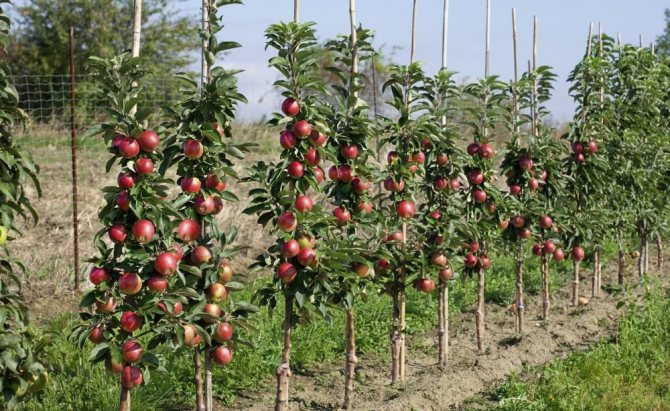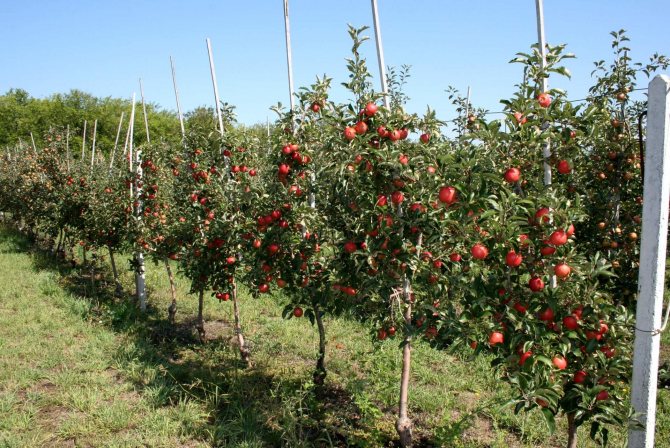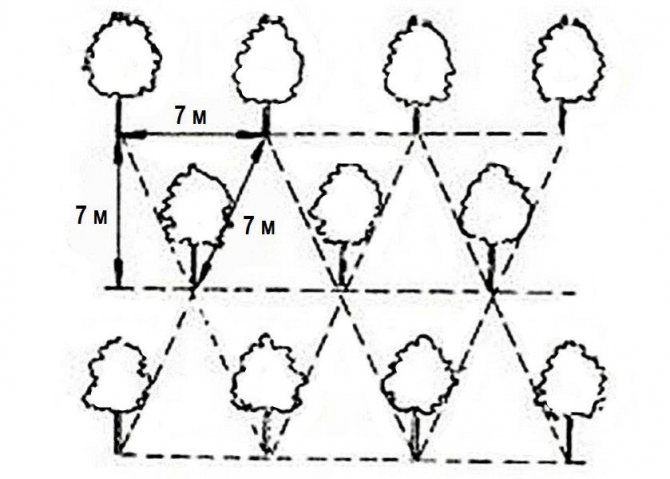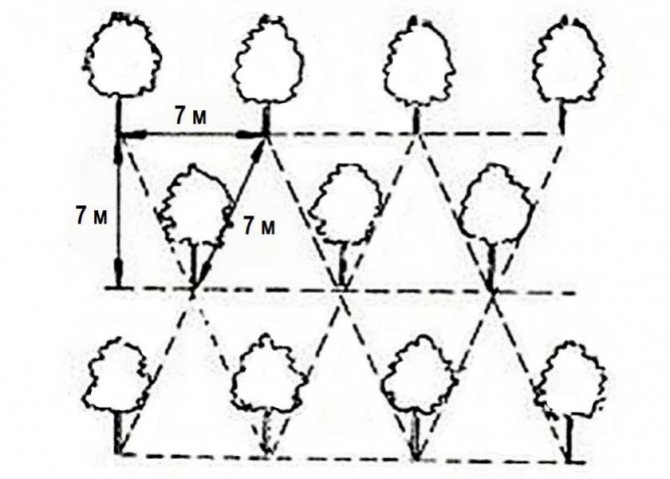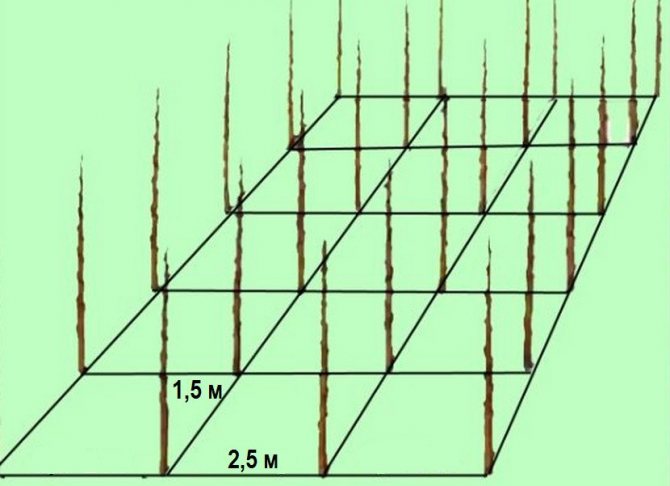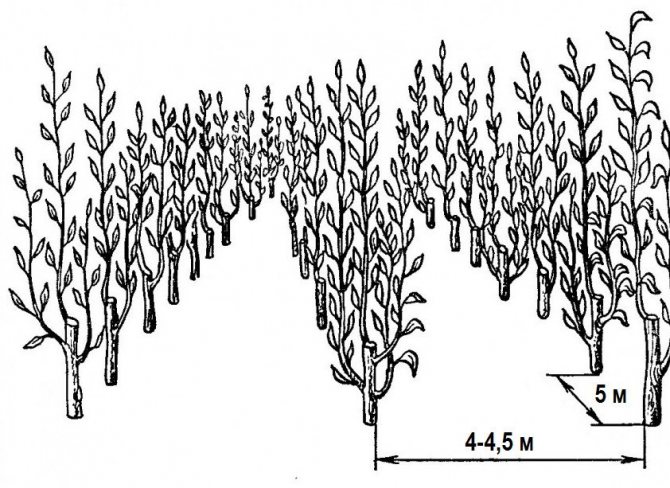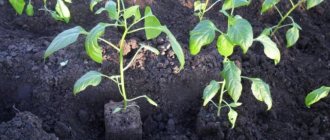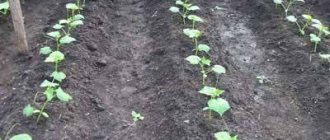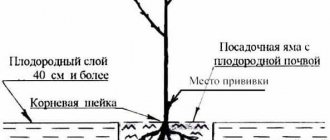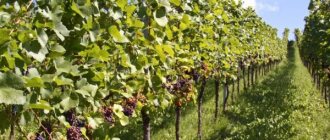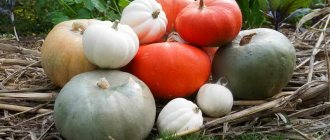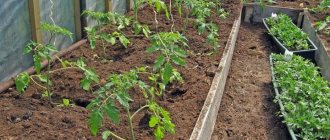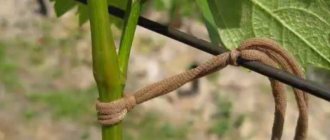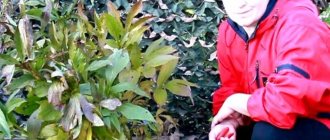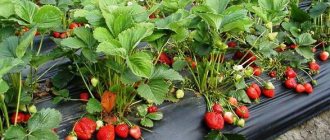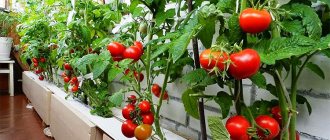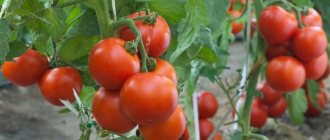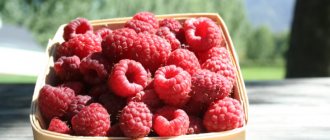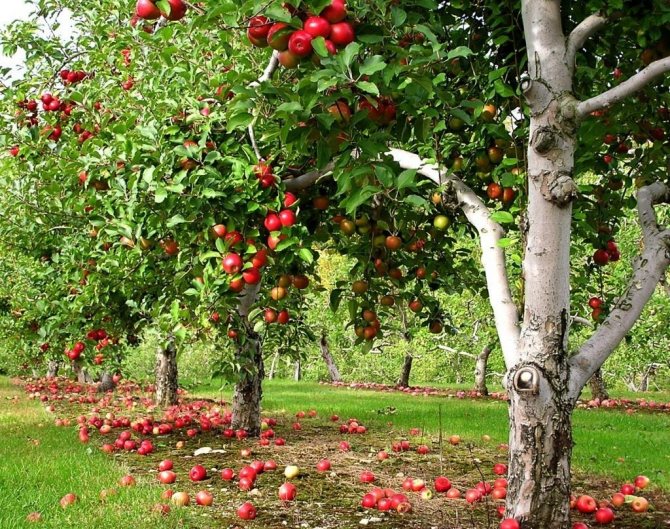
The most common mistakes beginner gardeners make are choosing the wrong place and planting fruit trees at the wrong distance from each other. These mistakes lead to irrational use of the area and a decrease in the productivity of the garden. Correcting them in the future is problematic, so you need to be very careful at the stage of laying the garden.
An overly dense arrangement of trees and shrubs slows down their growth and development due to the high level of competition for light, mineral nutrition and water. Under these conditions, it will not be possible to obtain the maximum yield either per tree or per unit area.
With rare planting, trees grow and develop well, give bountiful harvests. But if you recalculate the yield per square meter, then it will be below the optimal level.
The best compatibility of fruit trees will be achieved if plants of the same species are planted nearby: apple trees with apple trees, pears with pears, cherries with cherries. But such a garden of the same type will look rather boring. That is why trees of different types grow in our gardens, which are important to plant correctly. For example, a pear will feel great next to an apple tree and red rowan, while a cherry or peach will give it a lot of inconvenience.
How to plan a fruit tree garden
Planting trees and shrubs has its own characteristics. Before disposing of the land, it is recommended to develop a design project in compliance with the proportions of the site and indicating the location of all objects.
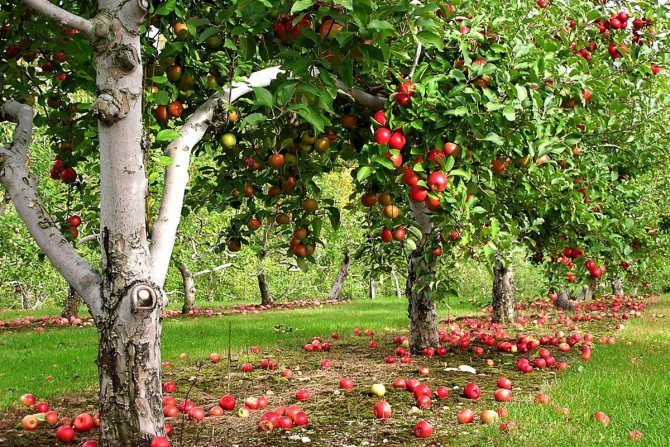

Garden
There are special computer programs for landscape design that help to plan the site, creating comfortable conditions for all plants and for the life of the owner in this garden.
Even a small suburban area can be turned into a garden. First, you should decide what species you want to plant. In this case, it is necessary to proceed from the characteristics of the climatic zone, soil and relief of the land plot.
The most convenient form for planning a garden plot is a rectangle. On the plan of a plot of this shape, all buildings are marked, the remaining territory is divided into sections with clear boundaries. The sections are planted with fruit and berry crops and ornamental plants, based on the individual preferences of the site owner. This layout method is suitable for those with narrow and long sections.
The opposite of rectangular is the layout of the site in the form of a circle. Its main elements are flower beds and lawns, the creation of patio yards. With this design, straight lines and corners on the territory of the site are recommended to be hidden behind climbing plants.
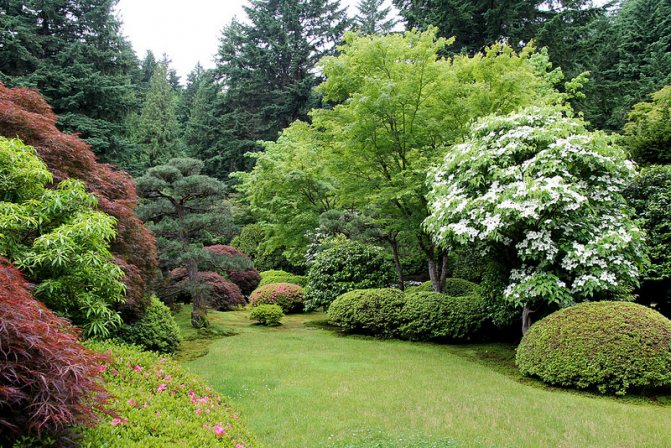

Plants in the garden
A professional landscape designer will help you to correctly design a round concept. The easiest way to embody the concept of a round shape in a square area.
The diagonal plot layout is ideal when you need to visually increase the size of a very small plot. With a diagonal layout, the house is the center of the composition, from which the plantings depart at an angle of 45 °. Depending on which direction the lines of the garden objects diverge, the effect of a longer or wider area will be created.
If the site has a complex relief, natural reservoirs, then a free type of layout is suitable for it. This form requires minimal maintenance. However, even for this type of landscape design, accents are required.
Distance between trees when planting fruit trees
Herbicides for the destruction of shrubs and trees
A close planting causes the roots to touch. This creates the danger of nutrient and moisture deficiency for one of them.
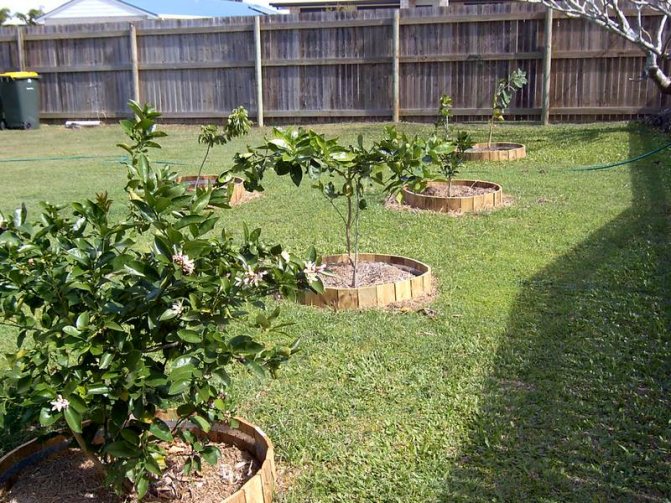

Distance between seedlings
When determining the distance between seedlings, you need to proceed from what the adult tree will be. Pears, apple trees, cherries, apricots grow tall, so the distance between their seedlings should be 5-6 m.For dwarf crops, a sufficient distance between seedlings will be 3-4 m.It is enough to leave 2 m between the columnar apple trees.
Planting apple trees distance between trees
Attention! Planting patterns for apple trees are different in different regions. So, in the southern regions of the Russian Federation, the distance between the seedlings and between the rows is increased, the planting is done in a checkerboard pattern. This is due to the characteristics of the soil.
Dwarf varieties are planted in 1 row at a distance of 2.5-3 m from each other. The gap between the rows should be 4-5 m. When semi-dwarf trees are planted, 4.5 meters are left between the seedlings and between the rows. For tall and tall varieties, the distance between trees is 5-5.5 m.
Sometimes apple trees are used as a hedge along the fence: they are planted in 1 row. If at the same time it is planned to form unusual forms in the form of arches, then it is enough to leave 1.5-2 m between the seedlings of dwarf varieties. The distance between the seedlings of medium apple trees is 5 m. For tall apple trees, it is necessary to leave 6 meters between the seedlings.
Additional Information. The staggered version of planting apple trees helps to rationally use the area of the site. In this case, 1.5 m are left between the seedlings of dwarf breeds, and 3 m between the rows. Semi-dwarf varieties are planted at a distance of 3.5-4 m, leaving 3 m between the rows. Tall apple trees on seed stocks are planted at a distance of 5-5.5 m, leaving the same amount between the rows.
Remember! The chess variant of planting apple trees requires careful and systematic care.
Distance between trees when planting columnar apple trees
Columnar apple trees grow well in the Moscow region and in the northern regions of Russia. The standard for the spacing between seedlings of this variety is 50 cm. When planting a columnar apple tree in rows every 1 m, leave 30 cm between the seedlings. So that each tree receives a sufficient amount of nutrients, the soil is abundantly fertilized before planting.
At what distance to plant tomatoes in a greenhouse
The correct arrangement of tomatoes in the greenhouse will help prevent the appearance of pests and diseases; providing each plant with the necessary amount of nutrition, moisture and lighting; simplifying the maintenance of plants.
Distance between rows of tomatoes
The most common way of planting tomatoes is row planting. This method is suitable either for open ground or for large-scale greenhouse complexes.
Considering the rules of parallel planting, it is quite possible to make a couple of rows between the aisles. Thus, you save space, while maintaining the ability to care for plants without any problems. According to this scheme, it is quite possible to place any variety, regardless of the height of the plant.
- I advise you to maintain a distance of 60 cm between plants in a row, you can expand up to 65, but more is already a luxury.
- As for the distance between the rows, 30-40 cm is quite enough.
- Leave more space between the beds - from 80 cm to 1 m.
| TIP To correctly determine the distance between the rows of tomatoes, you need to focus on the height of the plants: the higher they are, the greater the distance, and vice versa. |
Fertilizer for fruit tree seedlings
Young seedlings need mineral and organic fertilizers. The most demanded additives for a good harvest of apple trees are nitrogen, phosphorus, potassium. Additionally, you can use fertilizers with calcium, iron, sulfur, manganese. Top dressing should be comprehensive.
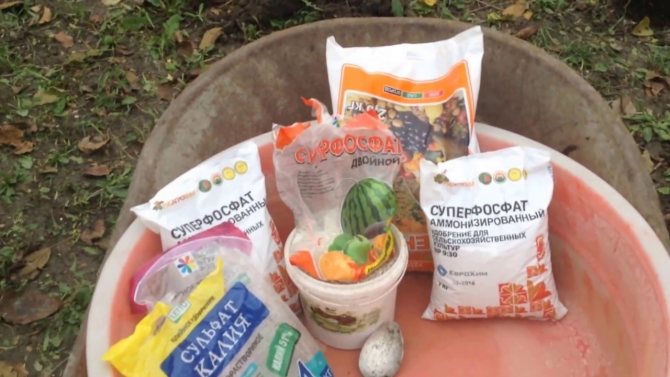

Fertilizers
Nitrogen is found in compost, manure, poultry droppings. They are diluted with water in proportions of 1:10. Fertilizers with nitrogen are used in spring, in combination with ammonium nitrate.
In the fall, 4 years after planting, fertilizers with phosphorus and potassium are introduced. Fruit crops can be fertilized with these mixtures during the formation of the fruit ovary or in spring.
Phosphoric acid is found in fertilizers such as superphosphate. This top dressing is suitable for all fruit trees.
Such preparations as nitrophoska, compositions "AVA" and "Autumn" have proven themselves well.
Attention! For weak seedlings, nitrogenous fertilizers cannot be used, as they will reduce the frost resistance of the tree, prolonging the growth period.
Podzolic and soddy soil is fertilized with ash, adding it to any organic dressing.
When to plant trees: fall or spring
Usually trees are planted or replanted only when they are dormant: in spring or fall. In the summer, such a procedure is unsafe, since the plants are in the midst of the growing process. And if you disturb a young tree at this time, then after suffering stress, it risks getting sick or even dying. How to determine which season to plant trees correctly? The choice depends on the climatic zone.
Planting (transplanting) trees
Southern regions. The trees are planted in the fall. Saplings planted in spring run the risk of not having time to take root before the onset of hot weather. Therefore, they can burn the bark or die from a lack of moisture in the soil.
Central regions. Trees can be planted in both spring and fall. Regardless of the time of planting, the result will be approximately the same: in a temperate climate, seedlings of fruit crops will successfully take root.
Northern regions. The trees are planted in the spring. Not too hot spring and summer will allow the plants to adapt and leave for winter dormancy in a timely manner. Fruit crops planted in autumn, on the contrary, will not be able to acclimatize in time and will die with the onset of the first frosts.
Planting shrubs
Seat selection
When planting shrubs, take into account:
- the illumination of the site by the sun;
- the degree of soil moisture;
- soil composition.
Distance between bushes
To determine the optimal distance between the bushes, you need to add the height of 2 adjacent bushes and divide the resulting amount by 3.
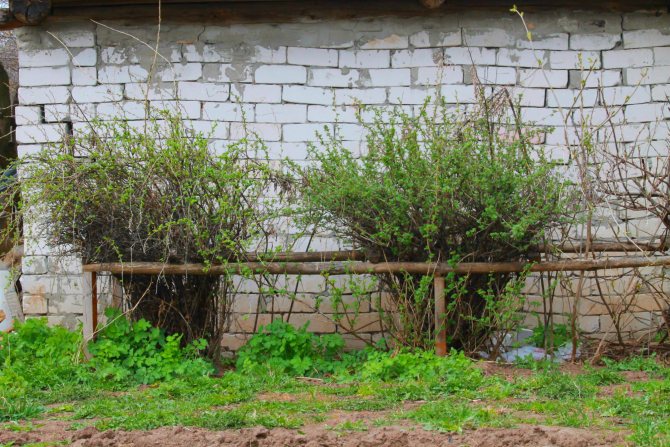

Distance between bushes
Problem number 1 - choose seedlings according to the state of the roots
This is especially important for those who buy ready-made seedlings on the market. First of all, you need to pay attention to the roots. Picked seedlings have a well-developed peripheral root system. That is, you can already visually determine that the plant will give out high rates of growth and development, only by examining a dense lump of roots. Accordingly, you can already figure out at what distance to plant tomatoes. Since the bush is large and strong, it means that it needs a lot of space. If the roots are of the rod type, it means that the plants did not dive. That is, they will build up their root power for a long time and only then will they start growing. Below we will take a closer look at what distance to plant tomatoes, but if the plants are deliberately late in growth, it can be significantly reduced.
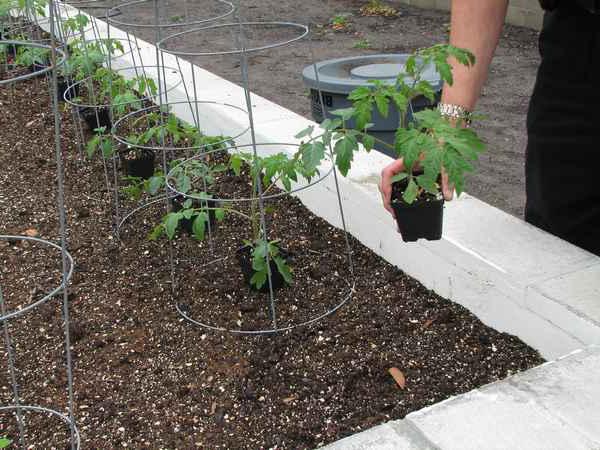

Fruit tree compatibility
Neighborhood table of fruit trees and shrubs
| Tree, bush | Good compatibility of trees and shrubs | Not suitable for the neighborhood |
| Apple tree | Raspberries | Viburnum, barberry and all stone bushes |
| Pear | Rowan | Walnut, cedar, viburnum, barberry and all stone bushes |
| Plum | Black currant, elderberry | Pear, apple, raspberry |
| Cherry | Sweet cherry, plum | Apple tree, raspberry, apricot, currant |
| Apricot | Feels more comfortable alone | Apple tree, plum, cherry, peach |
| Sweet cherry | Apple tree, rowan | Get along with all trees and shrubs |
| Peach | Feels more comfortable alone | Walnut, pear, apple, sweet cherry, cherry |
| Grapes | Pear | Nut |
What fruit trees can not be planted nearby
It is not recommended to place next to those fruit, which:
- They have common pests, are prone to the same diseases;
- Chemicals are released into the soil;
- They grow at different rates. The crop that develops faster will take a large amount of nutrients from the soil.
- They love moisture equally;
- They have a spreading crown, which can lead to a lack of sunlight.
Important! Conifers adorn the garden plot, but they are bad neighbors for fruit trees - their branches do not allow the fruit to receive enough sunlight.
Berry bushes compatibility
Black and golden currants will become wonderful neighbors. Red currants and gooseberries, grapes and raspberries get along well.
Sea buckthorn can be a good neighbor for fruit bushes. But its roots are growing rapidly, so they are limited to roofing material or slate.
Problem number 2 - choosing hardened specimens
Indeed, greenhouse plants will quickly bow their heads and will hurt for a long time, so you need to choose those that already know what the world around you is with its temperature drops and burning sunlight. It is very simple to choose such plants: greenhouse seedlings are light green, tender. And hardened plants, ready for all the twists and turns, have a rich dark green color with a bluish or purple tint. This point must be taken into account if you want to know exactly at what distance to plant tomatoes. Hardened bushes will quickly move into growth and grow large and thick, and greenhouse ones will be much smaller, with practically no side branches.
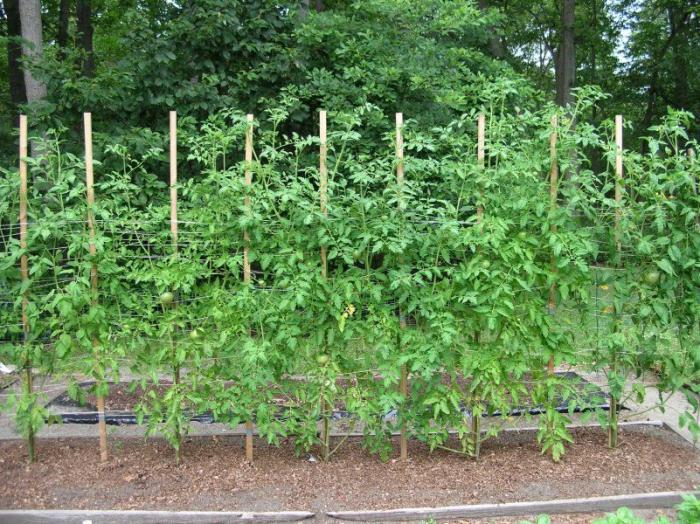

Tree propagation
Air layering
Almost any fruit tree can be propagated by air vents. For layering, healthy young branches are chosen that grow from the southern, southeastern or southwestern side. If the branch is tilted, it must be positioned vertically with the help of a guy line.
This breeding technology is done like this:
- In early spring, you need to put on a polyethylene sleeve on the branch, the diameter of which is 8-12 cm, the length is 35-40 cm. At the base of the branch, the edge of the sleeve must be tightly wrapped with insulating tape. At the end of March, closer to the strapping, you need to make 2 circular incisions in the bark of the branch to the middle. The distance between the cuts is 1.5-2 cm. The bark ring between the cuts is removed, this place is wrapped with electrical tape.
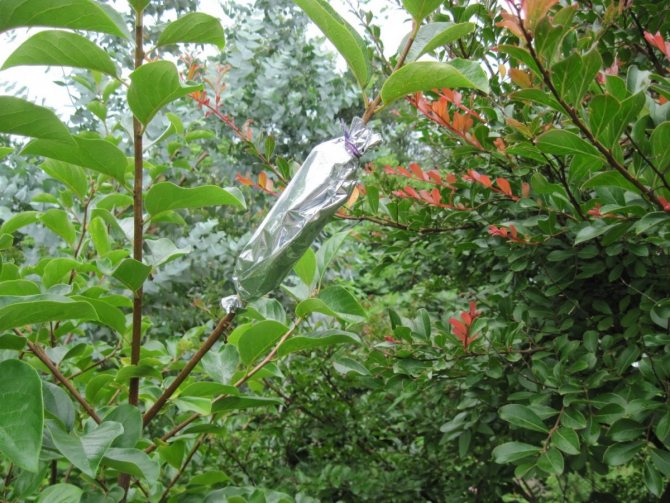

Air layering
- Above the annular cuts, 3-5 longitudinal cuts need to be made, the length of which will be 10-15 cm, the depth - 0.5-1 mm. Pour 1.5-2 liters of boiled water into the sleeve so that the water covers the incisions. Tie the upper end of the sleeve. The branch will stay in the water for 2-3 days.
- A layer of wet nutrient mixture of leafy soil and sifted rotted manure in proportions of 1: 2 is placed in the sleeve. The mixture is tamped so that there is no air left in the sleeve. 2-3 cm of mulch is laid on top of it. The edge of the sleeve is tied up.
- In September-October, the rooted branch is cut off and planted in the ground, without removing the mixture that was in the plastic sleeve. When the seedling is placed in the hole, the sleeve is removed. The hole is sprinkled with earth, watered. For support, the seedling is tied to a stick.
Cuttings
For the manufacture of the cuttings take healthy young shoots with green bark. The cut end of the cutting is placed in a container with water. For planting cuttings, cold greenhouses with a depth of 30-35 cm are ideal. A mixture of turf and sand is placed on the bottom, and coarse sand is placed on top.
Cuttings are planted in rows to a depth of 1-1.5 cm.For support, a peg is attached to each handle. Between the rows you need to leave 6-10 cm, between the cuttings in a row - 4-5 cm. After planting, the cuttings are watered through a sieve, covered with a frame and create a shadow for them. The temperature in the greenhouse is maintained at 20-25 ° C. Rooting occurs in 8-12 days.
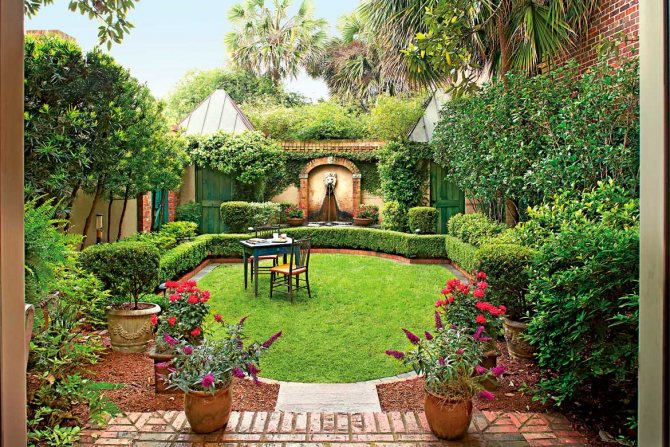

Beautiful garden
When the first shoots go on the cuttings, the greenhouse is slightly opened. The active growth of shoots indicates that the frame can be removed. At the end of August, cuttings can be planted in open ground. Before freezing, seedlings must be spud.
A beautiful garden is the dream of every land owner. In addition to the garden, I also want to have a vegetable garden. Knowing the simple rules for planning a garden plot and information about reproduction and proper planting of fruit crops will help gardeners to make their most cherished dreams come true.

